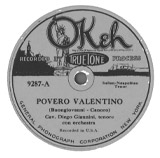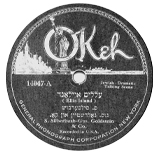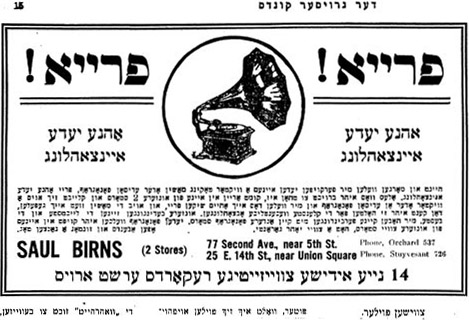Research Report
The Discography Project at Ellis Island Immigration Museum
by Eric Byron
Old, worn, and often severely scratched, phonograph records produced for mass consumption during the late 19th and early 20th centuries can provide interesting insights into American history. Millions of records were made through the 1950s, many of which convey how ethnic and non-ethnic communities in the United States viewed themselves and each other.
Anticipating what might be found on these recordings, staff and volunteers in the Museum Division of Statue of Liberty National Monument launched a cataloging project in 1997 to organize the information for research and analysis.(1) To date, the project has cataloged and collected data from approximately 100 different sources including books, online resources, and private collections. The author has collected more than 1,200 records and contributed recording equipment and a vintage windup phonograph to the project. Volunteer discographers have transcribed and translated recordings and entered information into a database that can be used to learn more about ethnic stereotyping, audience preferences, and other broad cultural patterns that are not perceptible in a single sound recording.
Brief History of Sound Recordings
Young recording companies began recording skits, songs, dramas, comedies and other popular forms of entertainment in the 1890s. Thousands of these early recordings, intended for a white audience,(2) exploited ethnic and other stereotypes, including rural populations. Cognizant of a burgeoning population of foreign-born consumers from places like southern Italy and Russia, the recording companies eventually shifted their marketing focus to include immigrant groups.(Figures 1-3) By the early 1920s, Victor and Columbia, the two largest companies, offered more ethnic recordings in their catalogs than non-ethnic ones.(3) Between 1900 and 1950, American companies produced over 30,000 different 78-rpm records targeting foreign-born communities.(4) A significant number of these recordings dealt with the everyday travails of new immigrants, including the difficulties of living in a new country.(Figure 4)
 |
Figure 2. This circa 1920 Slovak advertisement in Americky Kalendar Pre Slovakov-Luteranov reads "Sonora Phonograph. Buy one of these machines to have more fun at home, its voice is nice and sounds clear. It won the highest prize at the fair in Panama. Price $55.00 and up." Translation by Tomas Vajda. (Courtesy of the Immigration History Research Center.)
|
 |
Figure 3. The Okeh Phonograph Corporation made this 1926 recording for Neapolitan immigrants. (Courtesy of the author.)
|
 |
Figure 4. In 1922, Sam Silverbush recorded this Yiddish dramatic skit, "Ellis Island," in which an immigrant Jewish woman desperately fleeing a pogrom is interrogated by an immigration officer and reunited with her husband. (Courtesy of the author.) |
Scope of the Discography Project
The project database currently contains more than 7,000 entries and continues to expand. Each entry will eventually include details about the recording, its catalog, and matrix numbers (the matrix number is the number assigned to each master recording), ethnic focus, recording and release dates, keywords, and availability, along with transcriptions, translations (where necessary), and descriptive summaries.
When actual sound recordings are available, they are converted to CDs using a windup phonograph, recording equipment, and sound enhancing computer software.(5) The CDs are then transcribed and translated by volunteers.
The project uses ProCite reference management software, which allows researchers to access entries by keywords or conceptual units. Project volunteer Charles Lemonick created a customized worksheet for gathering information. He also advised the project team on data organization and entered all of the project data. As a result of his efforts, researchers can combine, separate, compare, and contrast recordings and parts of recordings.
Results
The cataloging project has revealed that almost every aspect of a recording is recycled or repeated. The two- to four- minute time limitation of the media did not allow for much variation in themes, plots, accents, or settings. Even the names of characters and the characters themselves were likely to be reused from one recording to the next. The number of recurring elements identified will likely increase as the project database grows.
The data collected thus far suggests that many, if not most, immigrant groups initially adopted the same English words and expressions, or created words and expressions that combined English and their native language. The recording companies often had the performers employ this language when making new records. Several of the borrowed English words and expressions, such as "boarder," "policeman," "job," "landlord," "that's alright," and "shut up," surface time and again, suggesting the kinds of relationships and situations new immigrants often encountered in America. Later recordings reflect much more complicated arrangements that have yet to be investigated fully.
Researchers can access the database by visiting the library of the Ellis Island Immigration Museum in New York. The project team is currently seeking volunteers to help transcribe and translate hundreds of additional recordings, the majority of which are in Yiddish and Italian dialects.
About the Author
Eric Byron is the coordinator of the Ellis Island Discography Project at the Ellis Island Immigration Museum of Statue of Liberty National Monument. He can be reached at eric_byron@nps.gov.
Notes
1. Volunteers are the driving force behind this project and are all the more important due to limited funding. Volunteer Charles Lemonick contributed nearly 8,000 of the roughly 12,000 hours donated to this project.
2. During the period in which most of these recordings were made (from the 1890s to the 1930s), few people distinguished between "race" and "ethnicity." In fact, the word "ethnicity" did not appear in Noah Webster's 1900 American Dictionary of the English Language (New York, NY: The Werner Company, 1900). [The word "ethnic" did, however, but it was defined as "heathen" or "pagan."] Steamship manifests from 1903 included a category for "race" or "people," under which appeared references to Italians, Hebrews, the Irish, Germans, Poles, and others. Yet, many Americans simply classified Northern Europeans as "white" and Eastern and Southern Europeans as "less-white" or "non-white." Such broad perceptions of race and ethnicity helped recording companies insofar as the perceptions identified potential audiences for their recordings.
3. Victor Greene, A Passion for Polka: Old-Time Ethnic Music in America (Berkeley: University of California Press, 1992), 77.
4. William Howland Kenny, Recorded Music in American Life: The Phonograph and Popular Memory, 1890-1945 (New York, NY: Oxford University Press, 1999), 67.
5. Although many recordings about ethnic groups can be found on the Internet, recordings by ethnic groups are rare. The project has relied on private collectors for access to the latter.

